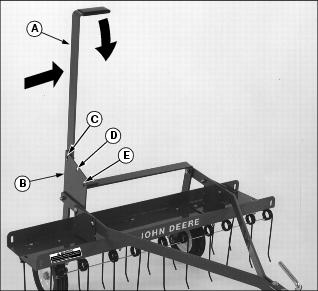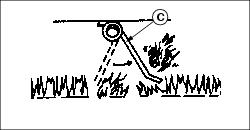
Operating - Thatcherator
When to Use the Thatcherator
The best times to dethatch are spring and fall. Grass should be less than 76 mm (3 in.) high for proper tine action.
Spring dethatching gives the grass a chance to grow strong before summer takes its toll, while a fall treatment will prevent pests from finding a fertile breeding ground in your lawn.
Use John Deere's tow-behind thatcherator to pull up excess thatch.
Selecting the Operating Positions
1. Park tractor safely. (See Parking Safely in the SAFETY section.)
2. Install thatcherator to tractor.
3. Push lift handle (A) toward left side of machine, away from lift lock plate (B).
4. Move handle forward or rearward to engage lock pin into desired position:
· TRANSPORT (C) - Use top hole to raise tines so unit can be towed without tines contacting the ground.
· DETHATCH (D) - Use center hole for general dethatching.
· SCARIFY (E) - Use bottom hole to scarify a seed bed.
Using the Weight Tray
1. Install thatcherator to tractor.
2. Place lift handle in top hole for transport position.
3. Add sand bags, concrete blocks, or other type of weight to weight tray (A). Do not exceed 45 kg (100 lb) of weight. Distribute weight evenly across tray to ensure equal tine pressure.
4. If necessary, secure weight in tray using straps.
Checking for Proper Tine Action
Grass should be less than 76 mm (3 in.) high for proper tine action during dethatching. The lift handle must be in the DETHATCH (center) position.
When in use, all tines on the thatcherator should deflect back and "flip" the thatch forward. If tines seem to drag without flipping forward, the tine tray is too low and should be raised. If all the tines stay in the free position, the tray should be lowered.
If the tines are not moving through the full range of motion, make up or down adjustments as required.
· In free position (A), tines are relaxed and not working.
· In position (B), tines are under tension and working.
· In position (C), tines are released and flipping thatch upward.
Adjusting for Proper Tine Action
NOTE: Make up or down adjustments by no more than 6.4 mm (1/4 in.) each time, until proper results are achieved.
1. Install thatcherator to tractor.
2. Add recommended weight to weight tray.
3. Tow thatcherator to a level concrete or asphalt surface.
4. Park tractor safely. (See Parking Safely in the SAFETY section.)
5. Place lift handle in center hole for detaching position.
6. Loosen bolts (A) on each side of weight tray mounting brackets.
7. Raise or lower weight tray to place tine tips about 13 mm (1/2 in.) above ground surface.
8. Tighten the weight tray bolts completely.
9. Push tines rearward to check adjustment. Tine tips should touch ground surface. If not, repeat the adjustment.
Checking Tractor Ground Speed
· Check ground speed in an open area.
· Measure a test area that is 30.5 m (100 ft) in length.
· Operate the tractor at wide open throttle. Operate tractor at a low speed and drive the tractor the test distance. Record the time needed to travel that distance.
· Make three passes, recording the time for each pass. The average time should be 14 to 23 seconds to achieve the recommended operating speed range:
· at 4.8 km/h (3 mph), the average time traveling the test distance should be 23 seconds.
· at 8 km/h (5 mph), the average time traveling the test distance should be 14 seconds.
· Adjust speed accordingly to achieve the recommended speed range.
Operating Thatcherator
1. Park tractor safely. (See Parking Safely in the SAFETY section.)
2. Install thatcherator to tractor.
3. Place unit in transport position.
4. Add recommended weight to weight tray.
5. Place unit in desired operating position.
6. Adjust unit to proper depth.
7. Place unit in transport position.
9. Park tractor safely. (See Parking Safely in the SAFETY section.)
10. Place thatcherator in desired operating position.
12. Tow thatcherator at 5 to 8 km/hr (3 to 5 mph) for safe and effective operation.
13. Check for proper tine action. Park tractor safely before making any adjustments.





